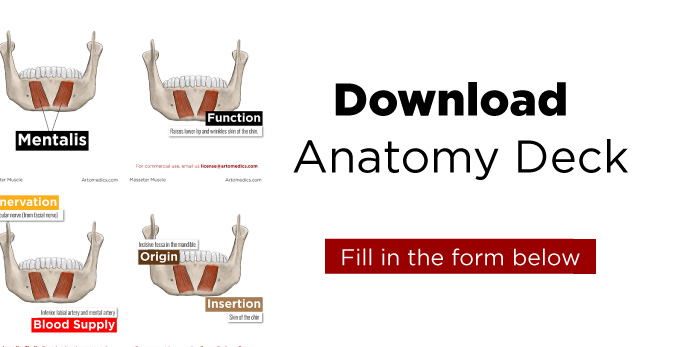Mentalis Muscle
Would a puppy dog pout ever be so cute without the involvement of mentalis muscles?
Perhaps not. it’s actions raise the fleshy parts of the chin and pushes the lower lip up, a powerful action engaged with both sides of the face always working in unison.

This muscle is present as a paired duo on each side of the chin, just off the midline. It has medial and lateral portions, with the lateral fibers (the outside parts) digging straight into the skin and the medial (the more towards the midline parts) going into the skin forward but also holding hands with their twins on the other side, sometimes creating a muscle fiber loop. You could say that they just miss each other.
| Innervation | Mandibular nerve (from facial nerve) |
| Blood supply | Inferior labial artery (from facial artery); mental artery (from maxillary artery) |
| Origin | Incisive fossa in the mandible |
| Insertion | Skin of the chin |
Mentalis muscle facts
The mentalis muscle originates from the incisive fossa in the mandible and inserts into the skin of the chin. It is innervated by the mandibular nerve (a branch of the facial nerve) and it’s blood supply comes from two sources: the inferior labial artery (from the facial artery, as most of the facial muscles) and the mental artery (hence it’s namesake) that is a branch of the maxillary artery.

What does the Mentalis Muscle do?
Upon contraction, the mentalis muscle raises the lower lip and wrinkles the skin of the chin (where it’s inserted). We engage this muscle when we purse our lips to express doubt and disdain (showing part of the inside of the lower lip). It also functions to as stabilizer for the lower lip.
When contracted, the chin looks more pronounced in the front view and small dimples for on the fleshy prominence of the chin.
This muscle is engaged when expressing sadness, anger, disdain, grief, doubt, determination and disgust.
Mentalis and depressor anguli oris can often be working together even if just for a moment, when making a face to emphasize something during conversation, (which isn’t exactly an emotion per se, just thought you should know).
The chin dimple
Plastic surgeons can create chin dimples on request.
When some fibers of the medial part are missing, the sticks to the fibrous pad, creating the chin dimple that is famously depicted in cartoons. Dimples are thought to enhance the beauty of the face and facial expressions. They can be seen in men and women, with no particular preference, and can happen on either side or both sides. They are inherited genetically as a dominant trait (so if one of the parents has it, probably the kids will have it, no doubt).
This is seen as a handsome trait in humans, so much so that many undergo “dimpleplasty“ , a procedure where a plastic surgeon create that much sough-after chin dimple by modifying the skin flap that lies just underneath the chin, thus making it concave, and allowing in the fibrous pad underneath to adhere into the skin, creating that “designer dimple”.
References
Standring, Susan. Gray’s Anatomy: The Anatomical Basis of Clinical Practice. , 2016. Print.

Leave a Reply